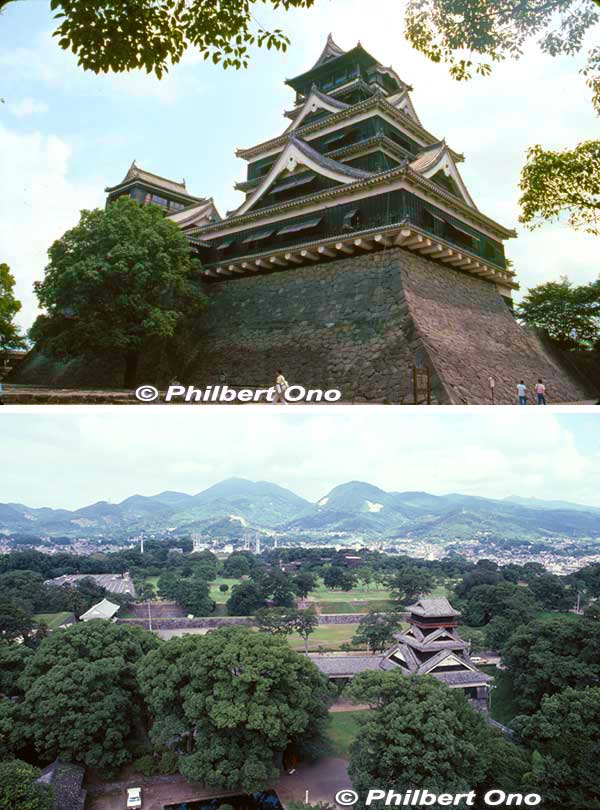
In April 2016, major earthquakes (M7) struck the city of Kumamoto and badly damaged Kumamoto Castle. Minutes after the earthquake, I noticed a dust cloud above Kumamoto Castle’s main tower in the live video footage of the city. It was caused by the roof tiles that fell off. Roof tiles are held in place with mud, so the dust came from the exposed dried mud.
Five years later in April 2021, speedy and priority repairs to the castle’s main tower (tenshukaku 天守閣) were completed and the main tower reopened to the public. It was a joyous milestone to see Kumamoto’s main symbol back in service without all the scaffolding. Looks like new with very white whites and black blacks on the exterior. We have to congratulate them for the great job and major morale booster for the city and prefecture. Hope to see it sometime.
Castle repairs are far from finished though. As of April 2021 with the main tower repaired, only about 20 percent of castle repairs have been completed. The main tower is actually a modern ferroconcrete building reconstructed in 1960 (upper photo). It houses a local museum. Since modern methods can be used to repair modern buildings, it was pretty quick to repair the main tower. However, repairing historic buildings is a different story.
The castle’s original, historic buildings and stone walls and foundations dating from over 400 years ago will be the most time-consuming and troublesome to repair and restore. Stringent Japanese regulations for repairing important and historic cultural properties require the buildings to be restored to their original condition as much as possible by reusing the original roof tiles, pillars, beams, etc., as much as possible. It’s a painstaking process.
The lower photo shows the Uto Yagura turret (宇土櫓) as seen from the main tower before the earthquakes. It’s one of the original castle structures over 400 years old. This turret, a National Important Cultural Property, was also damaged by the 2016 earthquakes, but repairs have not yet begun. The building fortunately didn’t collapse, but some of the exterior plaster peeled off, and the long, connecting corridor structure (partially visible on the left of the turret) totally collapsed. The turret’s 22-meter-high stone foundation is also slightly deformed, making the turret a tilted building.
To make repairs, they will have to dismantle the building and reassemble it using as much of the original materials as possible. The turret’s stone foundation and walls will also have to be meticulously deconstructed and reconstructed. The stones will be removed and marked so they can be reinstalled in their original pinpoint locations on the earthen wall. If a stone is broken, it must be fused back together and reused. Or if a substitute stone is necessary, it must be shaped to match the original stone’s shape. The earthen foundations and walls then have to be reshaped and reinforced. It may take 10 or more years to repair the Uto Yagura alone.
About 30 percent of Kumamoto Castle’s stone walls were damaged by the quake. That’s a lot of stones to remove and reinstall. Castle repairs are slated to be completed in 2037, 21 years after the earthquake and 16 more years. I hope to live long enough to see it, but space travel and tourists going to the moon might be in vogue by then. I might rather see the castle from a space ship. ![]()
![]() From JR Kumamoto Station, take a tram (17 min.) to Kumamoto Castle stop. Then a 10-min. walk. Or take a local bus (10 min.) to Sakuramachi Bus Terminal. Then a 10-min. walk.
From JR Kumamoto Station, take a tram (17 min.) to Kumamoto Castle stop. Then a 10-min. walk. Or take a local bus (10 min.) to Sakuramachi Bus Terminal. Then a 10-min. walk.
Official: https://castle.kumamoto-guide.jp/en/